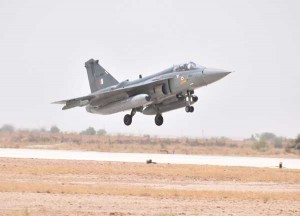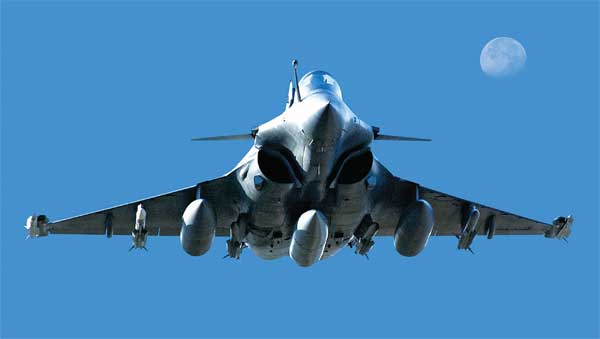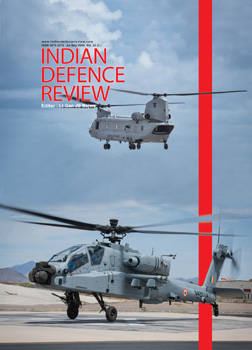The White Paper on China’s Military Strategy 2015 states, “In line with the strategic requirement of building air-space capabilities and conducting offensive and defensive operations, the PLAAF will endeavour to shift its focus from territorial air defence to both defence and offence.” When seen with the military reforms that reorganised the erstwhile Military Regions into five “theatre commands’ exercising joint control over all military forces including the comparatively new Peoples’ Liberation Army Strategic Support Force. Another concern is the raising of Tibet Military Command’s to a status higher than the other provincial commands, an indication of Chinese move to provide it with more resources for its self evident mission against India.
In the event of hostile action initiated by China on any of the disputed territories bordering India, Pakistan would open a second front in unholy haste…
In recent months, the term ‘two-front war’ has acquired prominence in any military-strategic narrative involving India and its two inimical neighbours – China and Pakistan. Allied debates speculate on the possibility of a two-front war, the probable scenarios it could throw up and the varying fortunes the three participants could hope to secure in the war. Given half an opportunity by way of hostile action initiated by China on any of the disputed territories bordering India, Pakistan would open a second front in unholy haste. The possibility of China doing likewise in case of an Indo-Pakistan military engagement exists but the likelihood of that happening is low. However, India needs to be or at least strive to be prepared for a two-front war.
The Indian Air Force (IAF) is currently listed as the fourth largest globally. However, the vast terrain it needs to defend against aerial attack and the enormous stretch of possible battle space in which to support surface forces, are daunting challenges even for its size. Moreover, the vast territories of China and Pakistan combined demand huge offensive capability for counter air operations. Notwithstanding the fourth largest pedestal it occupies, in absolute terms, currently, it is far short of what has been sanctioned in the hazy past as a desirable squadron strength of 42 combat squadrons; the current strength is around 32.
Chinese Threat Confronting The IAF
While India claimed diplomatic triumph over the 73-day confrontation at Doklam, Chinese troops continue to be present in the India-Bhutan-China tri-junction area and the Chinese establishment continues to reiterate that Doklam has always been under its jurisdiction. Both opposing militaries remain at a high state of build up despite an illusory diffusion of tension that had reached breaking point. Indeed, Doklam is a ticking time bomb that could detonate with a suddenness reminiscent of 1962, the year Chinese jolted India out of its somnolescence.
The last White Paper on China’s Military Strategy 2015 states, “In line with the strategic requirement of building air-space capabilities and conducting offensive and defensive operations, the People’s Liberation Army Air Force (PLAAF) will endeavour to shift its focus from territorial air defence to both defence and offence…”. When seen with the military reforms that reorganised the erstwhile Military Regions (MRs) into five ‘theatre commands’ exercising joint control over all military forces including the comparatively new Peoples’ Liberation Army Strategic Support Force. Another concern is the raising of Tibet Military Command’s status to one rank higher than the other provincial commands, an indication of Chinese move to provide it with more resources for its self-evident mission against India. The Chinese front by itself could be worrisome for India.
The Pakistan Air Force (PAF) is a highly skilled and well trained force with pride in its professional capabilities and a good exposure to modern aircraft and tactics through its relations with the West, especially the United States (US)…
As far as air power is concerned, China has been focusing on dual use airports in Tibet from which offensive and defensive missions could be launched. During the last two decades or so, the PLAAF has been modernised through indigenous aerospace industry support and licensed-production of Russian aircraft. A PLAAF Air Division holds around 72 aircraft. After reorganization, the Lanzhou and Chengdu MRs field air assets deployable against India. Chengdu MR had two fighter divisions (with J-7H, J-7II, J-10A, Su-27SK and J-11 fighters) and a transport division, whereas Lanzhou MR had two fighter divisions (J-7H, J-7II, J-8F, J-8H, JH-7A, J-11 and J-11B) and a bomber division (H-6). The prefix ‘J’ denotes a fighter and ‘H’ denotes a bomber. Thus there could be around 300 fighters and 72 bombers that could be tasked against India. The fighters with better performance (Su-27, J-10 and J-11/ J-11B) can be expected to be somewhat effective from the high elevation airports in Tibet while the others may be severely constrained operationally. In the future, J-20 and FC-31 fifth generation, multi-role, stealth aircraft could be expected to join the fray in Tibet; the former earliest in 2020 and the latter much after that. A new long range bomber (H-20) with nuclear capability, is under development but is not expected to complement China’s nuclear triad before 2025. This is a pithy summation of the PLAAF threat that the IAF would face in a war scenario.
Threat From Pakistan
The Pakistan Air Force (PAF) is a highly skilled and well trained force with pride in its professional capabilities and a good exposure to modern aircraft and tactics through its relations with the West, especially the United States (US). After the Pressler Amendment in 1985, the US imposed sanctions and an arms embargo on Pakistan, forcing it to explore other options. China stepped in willingly and supplied aircraft and equipment to the PAF which currently has 22 combat squadrons comprising about 465 combat aircraft (around 50 JF-17s with possibly another 100 on order, 75 F-16s, 75 Mirage IIIs, 80 Mirage Vs and 185 F-7s). The JF-17 Thunder is a Chinese design co-produced in Pakistan Aeronautical Complex, Kamra, Pakistan and Chengdu Aircraft Industry Group, China and is claimed to be a fourth generation, multi-role aircraft. The PAF plans to acquire a total of 250 JF-17 Thunder to replace its fleet of Mirage III and F-7. Some of the JF-17 would be Block 2 aircraft with 4.5 generation features while some more would be Block 3 which are expected to have fifth generation characteristics. The PAF is also said to have placed an order for 36 Chinese J-10 (4.5 generation) aircraft. The J-10 is expected to be inducted as the FC 20, an advanced PAF-specific variant. PAF is consistently and constantly endeavouring to remain close to the leading edge of combat aircraft technology.
Combined Effect
The PLAAF and the PAF have been conducting joint exercises since 2011 under a series named ‘Shaheen’. The sixth edition Shaheen VI was held in China’s Xinjiang province during September this year. At the end of this edition of the exercise, Chinese Defence Ministry spokesperson Colonel Wu Qian stated at a media briefing, “Speaking of Pakistan, the first word that comes to my mind is ‘Iron Pak’…If we characterise Pakistan-China military-to-military relations, the three key terms are ‘all-weather brotherhood, high-level mutual assistance and support and deep-rooted strategic mutual trust.” To the average Indian, such statements hold forth a foreboding portent of a two-front war.
As brought out earlier, the PLAAF and the PAF each singly pose a challenge to the IAF in the event of war with China or Pakistan. The IAF would certainly have operational plans in place for redeployment of its resources should any one of them have to be militarily confronted. Needless to say, a major re-orientation towards one possible adversary would be at the cost of leaving the frontiers with the other comparatively undefended. Standard risk assessment matrices play off probabilities of occurrence against severity of consequences. India needs to heed the fact that while the probability of a two-front war is low, the severity of its consequences on India would be disastrous. The IAF thus needs to be prepared for a two-front war.
 State Of Preparedness Of The IAF
State Of Preparedness Of The IAF
The Indian armed forces have always believed that the probability of a two-front war is high. However, public debate on the issue of two-front war was probably kick-started with the IAF telling the Parliamentary Standing Committee on Defence in February 2014, that it would be somewhat difficult to manage a two-front war with the strength of the combat fleet at 34 squadrons. The IAF, however, had plans to cope to the best of its ability if such a situation did arise. The media lapped up this news and the issue has remained in public domain since then.
“We need 42 squadrons for full spectrum of operations. But it does not mean that we cannot fight a two-front war with the existing strength. We have a Plan B for reduced strength, there are ways in which we can carry out the task,” said the CAS.
The issue came into focus once again when it was highlighted by Air Marshal BS Dhanoa, the then Vice Chief of the Air Staff (VCAS) who told media in March 2016, “Our numbers are not adequate to fully execute an air campaign in a two-front scenario.” A year and a half later, on Air Force Day this year, as the Chief of the Air Staff (CAS) Air Chief Marshal BS Dhanoa declared that the IAF was ready for a two-front war, adding that the probability of such a war was low. Some reports ludicrously claimed that the change in the perception of the IAF had been brought about by the BJP government. However, analysts have remained unimpressed by the Chief’s iteration as no momentous change has taken place in the IAF squadron strength since March 2016. There has also not been any significant reduction in the strength of the PLAAF or the PAF. According to the CAS, the IAF is likely to achieve a 42-squadron strength by 2032. Two years ago, the projection was 2022, possibly based on the proposed induction of 126 Rafale jets from Dassault Aviation of France. He reportedly said that, “We need 42 squadrons for full spectrum of operations. But it does not mean that we cannot fight a two-front war with the existing strength. We have a Plan B for reduced strength; there are ways in which we can carry out the task.”
It is not the intent of this section to detail all roles and tasks the IAF would perform in a two-front war as the scenarios that could be thrown up would be premised on too many variables. A rough comparison shows that the combat strength of the IAF is around one and half times that of the PAF. However, PAF aircraft match up in performance and its pilots are well paid, competent, highly motivated and enjoy first grade status.
IAF pilots are more proficient in advanced air combat tactics especially while operating in a Beyond Visual Range (BVR) environment. The IAF also enjoys significant equipment advantages over the PAF as it has larger numbers of high performance aircraft, operates more BVR-capable platforms, and deploys better on-board sensors and electronic warfare systems. The IAF possesses superior combat support aircraft, better infrastructure and a continually improving integrated air defence network. However, the steadily falling numbers of combat aircraft in the IAF could prove to be critical in the event of a large-scale or protracted war even with only Pakistan as the antagonist especially as the territorial expanse which is to be defended and supported by the PAF, would be much smaller than India’s. This factor could be seen as a disadvantage for the IAF as it would have to spread its resources thinly as compared to the PAF.






